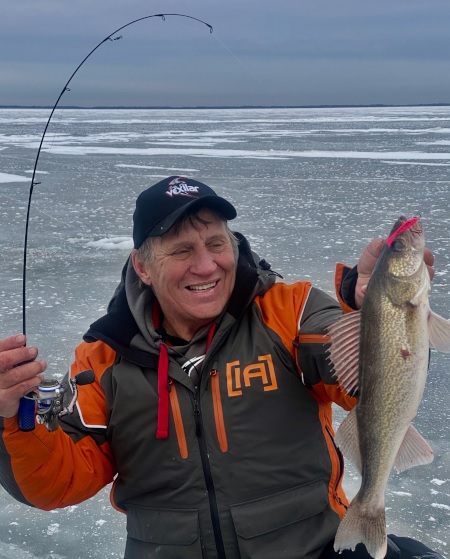 While walking down the aisles recently of the local bait shop, I couldn’t help but be somewhat astonished by all the ice rod models available! This experience had me thinking back to my ice fishing trips with my Dad and brother as a kid and the ice rods we used.
While walking down the aisles recently of the local bait shop, I couldn’t help but be somewhat astonished by all the ice rod models available! This experience had me thinking back to my ice fishing trips with my Dad and brother as a kid and the ice rods we used.
Our ice fishing rods “back in the day” were basically wood pieces that resembled narrower and shorter broom handles. They had a couple of pegs a few inches apart that held the fishing line and what appeared to be the sharp end of a nail stuck out one end of each rod for standing the rods up on the ice.
We used these rods by unwinding the line from the pegs, tying on a lure, and then sliding the lure and the line down the fishing hole. We usually fished minnows on hooks or on jigs beneath bobbers. And, Dad would occasionally remind us to “jig up” the bobber to give the lure and bait some action that would hopefully attract fish!
When the bobber slid under the water, indicating a biting fish, we would make sure enough line was off the peg to the let the fish “run” and take the bait. After a few moments, we’d slowly pull up the slack line until we felt the weight of the fish and then give a quick, upward pull to set the hook. If we hooked the fish, we hand-over-handed to pull the line and fish up and through the hole. And, somewhat amazingly, we caught fish!
But my, how things have changed!
Today, though fish still get caught using bobbers, spoons and glide baits fished using various jigging methods rule amongst the ice angling crowd. And, we often use fast action ice jigging rods that resemble mini versions of their longer open-water counterparts to effectively work these baits.
Like summer rods, the shorter ice jigging versions are often made of premium graphite, feature top quality guides, and have comfortable, sensitive grips too. Because winter jigging is a game of “feel,” premium graphite rods can boost your successes because they’re lightweight and very sensitive. My favorites are the Dave Genz Legacy Rods made of top components that come in models specifically designed for using various lure styles when jigging for walleyes and crappies, two of my favorite winter targets.
Quality jigging rods used to present jigging spoons and other lures are fun to fish with and often add to the catch when targeting walleyes and crappies. When bluegills or perch are targeted, however, anglers switch to smaller, lighter jigs to tempt bites. And, lighter lures often fish best on rods featuring spring bobbers.
The spring bobber is a small spring in the rod’s tip that visually “gives” or bends to a biting fish, making it easy to see when a panfish takes a light bait. Some rods come with built-in spring bobbers, though spring bobbers can be purchased separately and added to other rods. Without a spring bobber, sensing light bites on light jigs can be difficult. The Scepter Stick line of rods has a couple of quality, affordable spring bobber rods that work very well for light jigs and panfish and are my favorites.
Ice fishing remains one of my favorite winter activities. While we caught fish back in the day when I was a kid, today’s jigging lures often put even better catches on the ice. And, using a quality jigging rod with some of the features just mentioned, makes ice fishing more fun and more successful. As always, enjoy your time on the ice and remember to include a youngster in your next fishing trip!
By Mike Frisch – Mike Frisch hosts the popular Fishing the Midwest TV series. Visit www.fishingthemidwest to see more fishing tips and view recent TV episodes as well!
